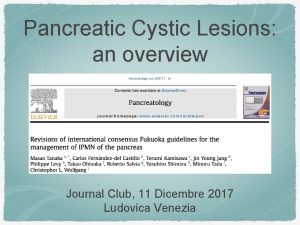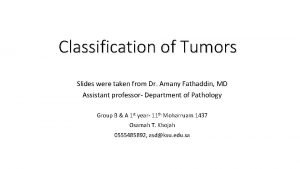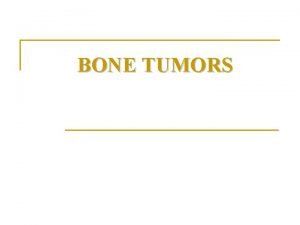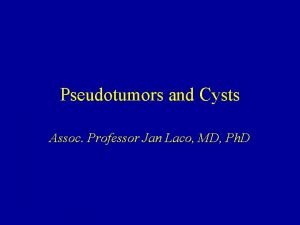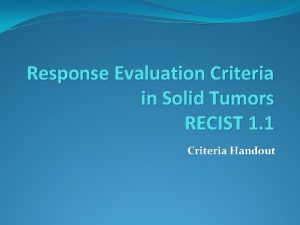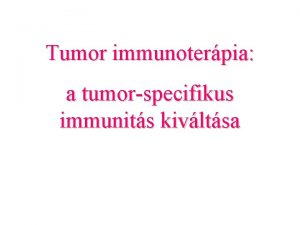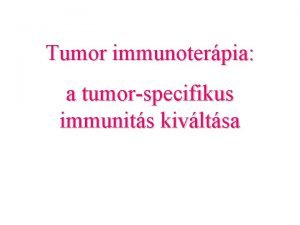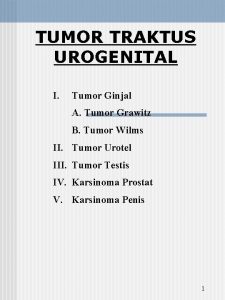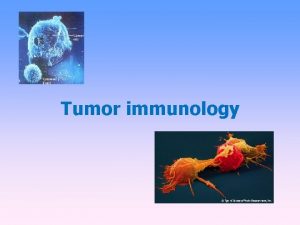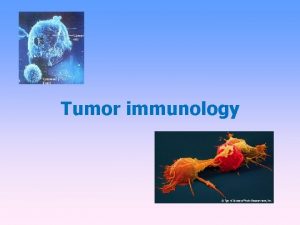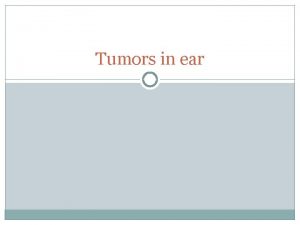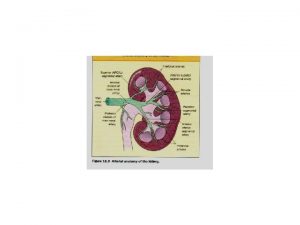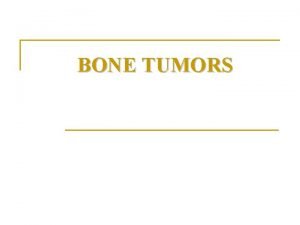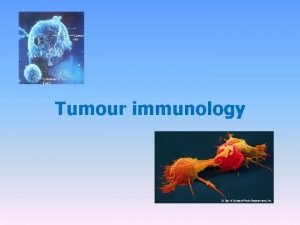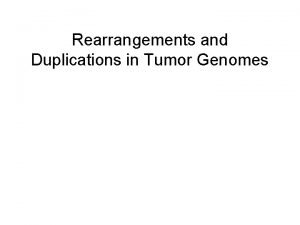TUMORS HAITHAM R ELMEHDAWI TUMORS Definitions TUMOR Autonomous




























- Slides: 28

TUMORS HAITHAM R. ELMEHDAWI

TUMORS Definitions • TUMOR • Autonomous • Excessive • Purposeless • Pathological Proliferation of cells. This growth continues in the absence of physiological stimuli & without regard to its effects to the surrounding tissue

TUMORS Definitions • • Neoplasia Hypertrophy Dysplasia Carcinoma “in situ” Invasive Carcinoma Metaplasia

TUMORS

TUMORS Hyperplasia proliferation of cells within an organ that may result in gross enlargement in response to a physiological stimulus, remains under normal regulatory control mechanisms. (breast during pregnancy) Hypertrophy increased in cell size. (weight training & steroid therapy)

TUMORS Dysplasia • Literally means abnormal growth • In dysplasia some but not all of the features of malignancy are present, microscopically • Dysplasia may develop into malignancy (Premalignant condition) Uterine cervix Colon polyps • Graded as low-grade or high-grade, often prompting different clinical decisions • Dysplasia may NOT develop into malignancy • HIGH grade dysplasia often classified with CIS

TUMORS Metaplasia changes in response to chronic physical or chemical irritation such as cigarette smoking that causes the mucus secreting Ciliated epithelium to be replaced by Simple Squamous epithelium; the change is benign and reversible to certain limit Some cells go from: Metaplasia-Dysplasia-Neoplasia

TUMORS Carcinoma “in situ” • Epithelial neoplasm with features of malignancy • altered cell growth • cytological atypia • altered differentiation BUT-no invasion through basement membrane

TUMORS

TUMORS

TUMORS TAYPES OF TUMORS

TUMORS

TUMORS MACROSCOPIC FEATURES Characteristics Benign Malignant Boundaries Encapsulated /circumscribed Irregular Rate of growth Usually progressive & slow may be slow to Rapid Local invasion not invade or infiltrate surrounding normal tissues Locally invasive, infiltrating the surrounding normal tissues Metastasis Absent Frequently present

TUMORS MICROSCOPIC FEATURES Characteristics Benign Malignant PATTERN structure may be typical of tissue of origin structure is often atypical Nucleo/cytoplasmic ratio Normal Increased pleomorphism Absent present Hyperchromatism Absent present

TUMORS Benign Dysplasia In-situ Invasive POSSIBLE EVENTS Dysplasia In-situ Benign Dysplasia In-situ Invasive

TUMORS NOMENCLATURE Tissue Epithelial tissue Benign Malignant • Papilloma • Adenoma • Squamous cell carcinoma • adenocarcinoma • Lipoma • Osteoma • Leiomyoma • Liposarcoma • Osteosarcoma • Leiomyosarcom Nerves tissue • Neurofibroma • Neurofibrosarcoma Lymphoid /blood • Haemangioma • Haemagiosarcoma Connective tissue

TUMORS NOMENCLATURE • • • HEMATOMA TERATOMA SEMINOMA LYMPHOMAS MALIGNANT MELANOMA HEPATOMAS

TUMORS

TUMORS Epidemiology of cancer • Cancer is one of the most common diseases in the developed world. • 1. 4 million new cases diagnosed. • 1 in 4 deaths are due to cancer • 1 in 17 deaths are due to lung cancer

TUMORS • Most common tumors in men 1. Lung 2. Prostate 3. Colorectal • Most common tumors in women 1. Breast 2. Lung 3. Colorectal

TUMORS Etiology of cancer • • Exposure to environmental carcinogens Dysregulated DNA repair Random replication errors Hereditary germline mutations in a cancer gene

TUMORS Genes responsible for cancer • • Oncogenes Tumor-Suppressor Genes regulating apoptosis Gene regulating DNA repair

TUMORS Genes responsible for cancer

TUMORS

TUMORS

TUMORS Cancer Etiologic factors • Smoking • 30% of all cancer deaths • 87% of lung cancer deaths

TUMORS Cancer Etiologic factors

TUMORS
 Haitham hassanieh
Haitham hassanieh Exocrine tumors of pancreas
Exocrine tumors of pancreas Bone tumors
Bone tumors Acromely
Acromely Classify odontogenic tumors
Classify odontogenic tumors Cervical ectropion
Cervical ectropion Classification of tumors
Classification of tumors Bone tumors
Bone tumors Odontogenic tumors classification
Odontogenic tumors classification 60% of15
60% of15 Thyroid tumors
Thyroid tumors Peter hino md
Peter hino md Classification of tumors
Classification of tumors Spinal cord tumors
Spinal cord tumors Enneking staging
Enneking staging Benign and malignant tumors
Benign and malignant tumors Response evaluation criteria in solid tumors (recist)
Response evaluation criteria in solid tumors (recist) Odontogenic tumors
Odontogenic tumors Brain tumors
Brain tumors Teratoma
Teratoma Autonomous benthic explorer
Autonomous benthic explorer Autonomous competence stage
Autonomous competence stage Autonomous vs conditional specification
Autonomous vs conditional specification Condom catheter
Condom catheter Cambridgeshire autonomous metro
Cambridgeshire autonomous metro Autonomous to lightweight mode upgrade tool
Autonomous to lightweight mode upgrade tool Frontal lobe function
Frontal lobe function Autonomous people mover
Autonomous people mover What are autonomous actions?
What are autonomous actions?

